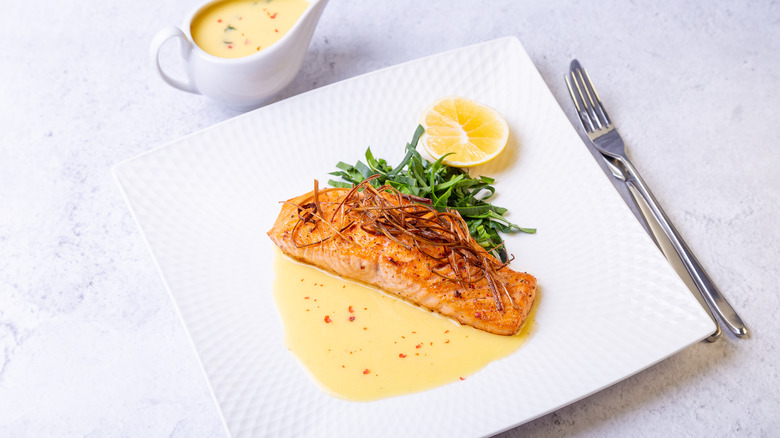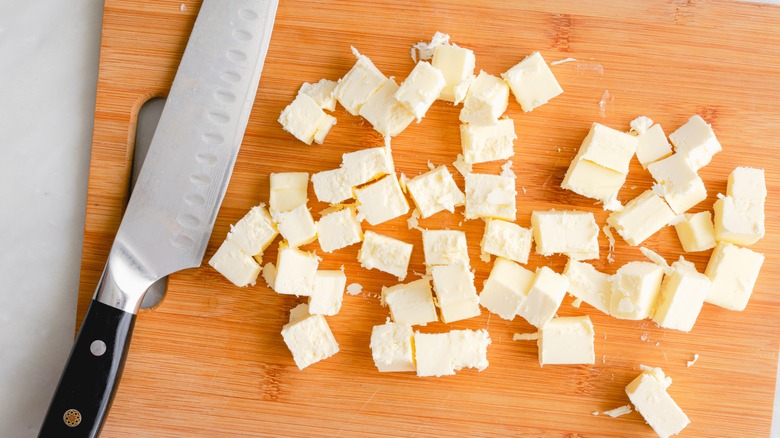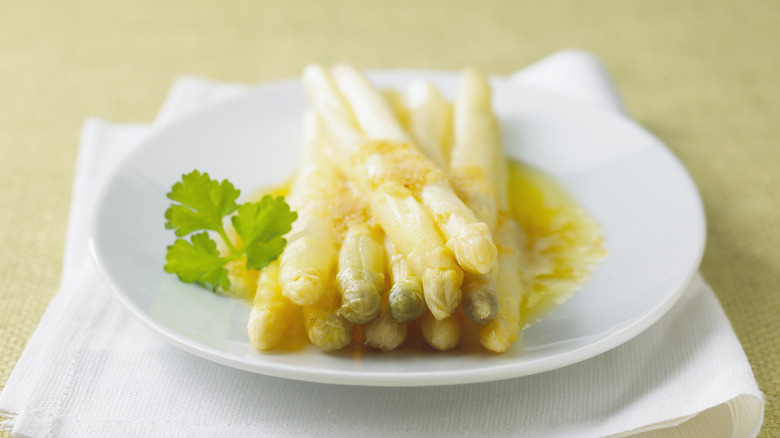Beurre Blanc Is The Bright French Sauce To Accompany Fish Dishes
French cuisine's five mother sauces may receive a bulk of the attention, but that doesn't mean they're the only ones worth crafting. Even a slight difference in ingredients and technique can tailor a sauce to certain dishes.
Take beurre blanc, for example. It's comprised of an emulsified butter base, so it'd be easy to mistake it for hollandaise. However, the inclusion of shallots and white wine gives it a savory and slightly tangy feel that makes it a delicious accompaniment to seafood, especially white-fleshed fish.
Unsurprising, then, that the sauce hails from coastal origins, emerging around the western city of Nantes, France. It's a relatively new creation that came about at the tail end of the 19th century. However, now, it's a stalwart of culinary schools, with keen attention to detail required to nail down the texture. Sure, it takes some effort, but the decadent texture is worthwhile and begs the question: How exactly does this sauce come together?
How beurre blanc is made
As per its name, beurre blanc starts with butter. And to create such a decadent texture, it requires a fair amount of it — up to two sticks per cup of the sauce. Incorporating cold butter gradually is critical, or else the sauce will break, so it's best to cut it into cubes before starting.
First, the shallot and white wine reduction is prepared. There are two ways to craft the mixture. In the first, more traditional method, thinly sliced shallots are quickly cooked down in butter. Their texture is closely monitored to ensure no toasted brown bits form. Once translucent, the white wine vinegar and white wine are added to the pan. While a French dry wine like Muscadet is the most classic, any low-sugar white works for the job.
Once the mixture cooks down to only a tablespoon, a couple of cubes of butter are slowly introduced. They're whisked in, and once melted, the next batch is introduced. During the process, the temperature is closely tracked, ensuring it never exceeds 65 degrees Fahrenheit. Whenever the beurre blanc achieves a beautifully thick consistency, it's salted, sieved, and ready to serve.
In other methods, heavy cream is added to the recipe to stabilize the emulsification. The reduction comes together with the wine, vinegar, and shallots boiled in one go. Once thickened, the cream and salt are stirred in. Then, the incremental addition of the butter is the same as in the classic method.
How to cook with beurre blanc
Once prepared, it's best to swiftly spoon beurre blanc on a dish and dive in. The sauce isn't stable for long durations, prone to breaking once cooled down. If you do need to delay its consumption, keep it warm on very low heat for up to an hour and mix in some cream right before serving.
Most classically, the sauce shines atop a white fish like cod, pike, or bass, although salmon works too. The sauce's savory note accentuates other seafood too, like scallops or shrimp. And instead of using hollandaise over a plate of asparagus, spoon this sauce for a just as tasty alternative.
The sauce's few flavors make it suitable for additional deviations, too. Some start by integrating a kick with the addition of white pepper or cayenne. You can also give it a tangy twist by replacing the vinegar with lemon juice and zest. And to make it a dressing for a beef dish, modify it to a red wine base for a heartier version. No matter how it comes together, the rich butter consistency will give the dish a decadence unlike anything else.


